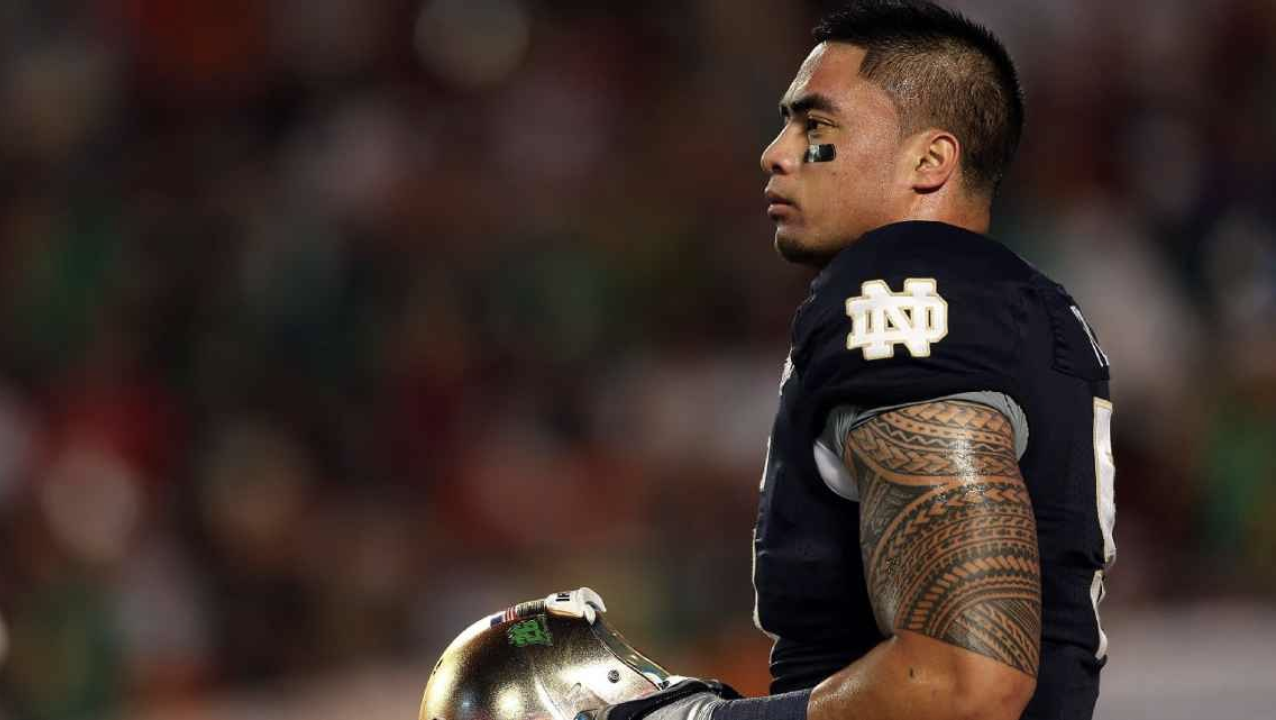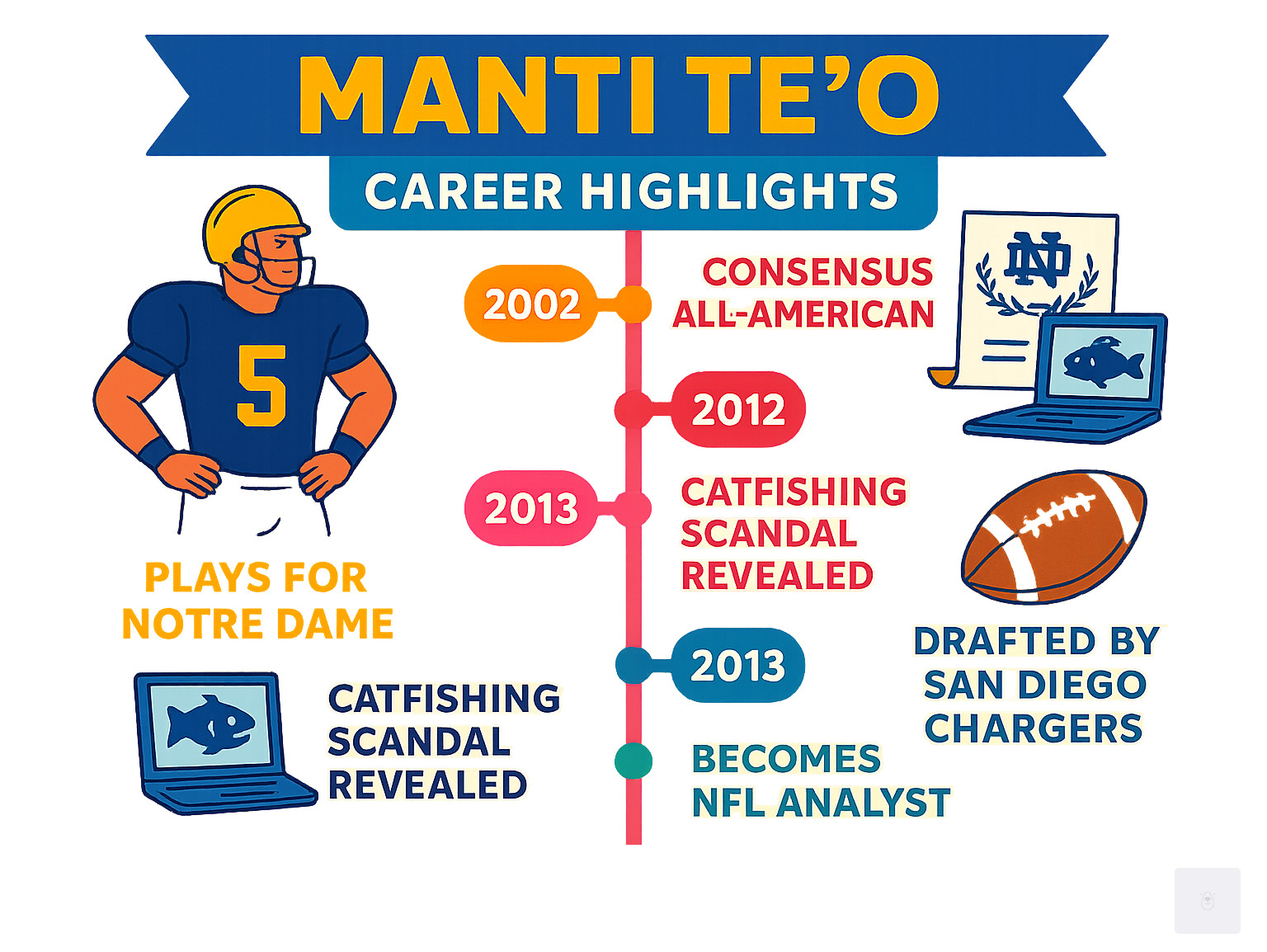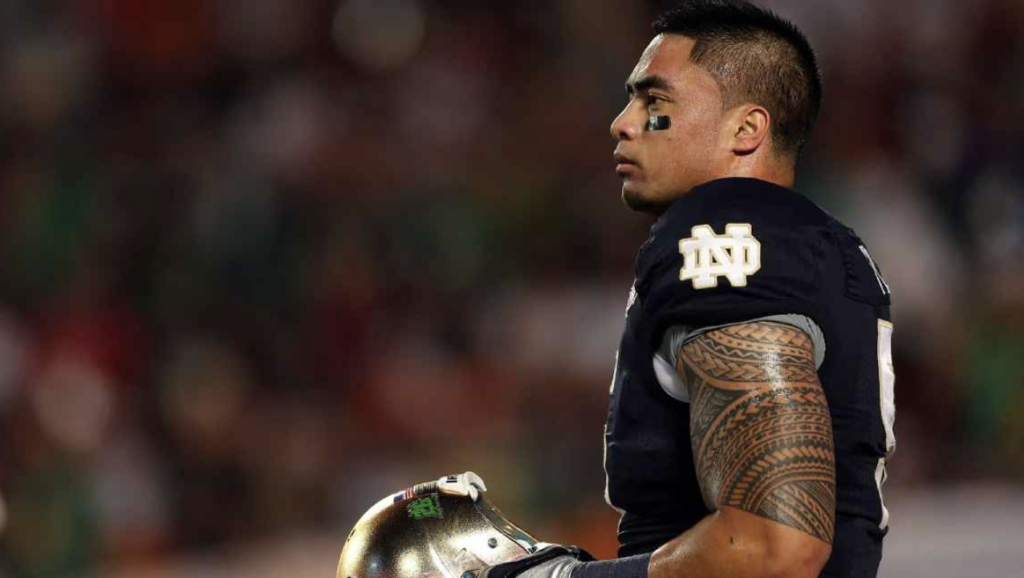
From Football Hero to National Headline
Manti Te’o is a former NFL linebacker who became one of the most talked-about figures in sports history – not just for his incredible college football career, but for being the victim of one of the most elaborate hoaxes ever to captivate the media.
Quick Facts About Manti Te’o:
- Age: 33 years old (born January 26, 1991)
- Birthplace: Laie, Hawaii
- College: Notre Dame Fighting Irish (2009-2012)
- NFL Career: San Diego Chargers, New Orleans Saints, Chicago Bears (2013-2020)
- Famous For: Heisman Trophy finalist, catfishing scandal victim
- Current Role: NFL Network analyst and commentator
Te’o’s story reads like a Hollywood script. He rose from a small Hawaiian town to become Notre Dame’s defensive leader, finishing second in Heisman Trophy voting in 2012. But just as he reached the pinnacle of college football success, a devastating scandal broke that would forever change his life.
The linebacker was the victim of an elaborate catfishing hoax involving a fictional girlfriend named Lennay Kekua, created by Ronaiah Tuiasosopo. The story exploded across media outlets from New York City to Los Angeles, turning Te’o from a celebrated athlete into a national punchline overnight.
Yet Te’o’s journey didn’t end there. He went on to play seven seasons in the NFL, recording 307 career tackles before transitioning to broadcasting. Today, he’s rebuilt his reputation and found peace with his past.
As someone who has spent over 40 years navigating the complex world of media and public relations in New York City’s elite circles, I’ve witnessed how quickly public perception can shift and how challenging it can be to rebuild a tarnished image. Te’o’s story offers valuable lessons about resilience, forgiveness, and the power of controlling your own narrative in our digital age.

Basic Manti Te’o glossary:
The Golden Dome’s Shining Star: Te’o’s Notre Dame Career
Long before the world knew him as the victim of an elaborate hoax, Manti Te’o was simply one of the most dominant defensive players college football had ever seen. His four years under Notre Dame’s iconic golden dome weren’t just about football – they were about building a legacy that would inspire teammates and fans from South Bend to New York City.
When Manti Te’o arrived at Notre Dame in 2009 from his small Hawaiian hometown, few could have predicted the impact he’d make. His very first collegiate tackle? None other than future NFL star Colin Kaepernick. It was a fitting introduction to what would become an extraordinary career.
The numbers tell part of the story. Over four seasons, Te’o racked up an incredible 437 career tackles, placing him third in Notre Dame’s storied history. But statistics only scratch the surface of what made him special.
Te’o’s 2012 senior season was the stuff of legend. He led the Fighting Irish with 113 tackles and recorded 7 interceptions – the most by any linebacker in college football since 2001. That kind of ball-hawking ability from a linebacker was almost unheard of.
His performance was so exceptional that he finished second in Heisman Trophy voting, joining an elite group of defensive players to reach such heights. When sports writers and fans across the country – including those covering college football in New York City – cast their ballots, Te’o’s name was consistently at the top.

But Manti Te’o was more than just a tackling machine. He embodied the Notre Dame spirit in every way. As team captain, he led by example – a leadership style deeply rooted in his Polynesian heritage. While other players might have been all flash and swagger, Te’o was about substance.
His teammates often spoke about how he’d take time to chat with campus employees, asking about their families and showing genuine interest in their lives. This wasn’t for show – it was simply who he was.
The decision to return for his senior year instead of entering the 2012 NFL Draft spoke volumes about his character. Te’o wanted to finish what he started at Notre Dame, and his commitment helped lead the Fighting Irish to an undefeated regular season in 2012.
Off the field, he maintained a 3.296 GPA as a design major while volunteering with the Special Olympics and Head Start Preschool programs. As an Eagle Scout, service was simply part of his DNA.
A Legacy of Excellence
Manti Te’o’s trophy case from his Notre Dame days reads like a who’s who of college football honors. His senior season was particularly remarkable, as he swept virtually every major defensive award available.
The Maxwell Award, Walter Camp Award, and Chuck Bednarik Award all found their way to South Bend thanks to Te’o’s incredible play. He also claimed the Bronko Nagurski Trophy, Butkus Award, and Lombardi Award – a clean sweep that’s rarely seen in college football.
His unanimous All-American selection was the cherry on top of a season that saw him become a household name from coast to coast. Sports fans in New York City coffee shops and bars were debating whether a linebacker could actually win the Heisman Trophy.
Beyond the hardware, Te’o earned Academic All-American honors in both 2011 and 2012, proving that his excellence extended far beyond the gridiron. His Mormon faith played a central role in how he approached both football and life, providing the foundation for the character and integrity that made him beloved at Notre Dame.
The national recognition wasn’t just about his athletic ability – it was about the complete package he represented. In an era when college athletics often focused solely on winning, Te’o reminded everyone that student-athletes could excel in every aspect of their lives while maintaining strong personal values.
His on-field dominance combined with his genuine character made him the kind of player that coaches dream about and fans naturally gravitate toward. It’s what made his later ordeal all the more heartbreaking – and his eventual redemption all the more inspiring.
The Hoax That Shocked the World: The Lennay Kekua Story
Just as Manti Te’o reached the peak of his college career, a story broke that would forever change his life. What started as a heartbreaking love story became one of the most shocking hoaxes in sports history, captivating media outlets from New York City to Los Angeles.
During his incredible 2012 season, Manti Te’o had shared what seemed like a deeply personal tragedy. He told the world that both his grandmother and his girlfriend, Lennay Kekua, had died within hours of each other in September 2012. The story was heart-wrenching – a young man playing inspired football while grieving two devastating losses.
The media acceptd this narrative completely. Sports writers and broadcasters painted Te’o as the ultimate example of strength and resilience. He spoke movingly about how their memory motivated him on the field, and fans across the country were touched by his courage.
Then came January 16, 2013. The sports website Deadspin published an investigation that shattered everything. Lennay Kekua didn’t exist. She was a complete fiction, created by someone named Ronaiah Tuiasosopo, who Te’o had known from his past.
The revelation hit like a thunderbolt. News outlets in New York City and beyond scrambled to understand how such an elaborate deception was possible. The story dominated headlines for weeks, with everyone asking the same question: How could this happen?
For Manti Te’o, the public humiliation was immediate and brutal. One day he was college football’s golden boy, the next he was the subject of late-night comedy sketches and internet memes. The change from hero to punchline happened almost overnight.
The scandal couldn’t have come at a worse time. Te’o was preparing for the NFL Draft, where his entire professional future hung in the balance. Suddenly, scouts weren’t just evaluating his tackling ability – they were questioning his judgment and wondering if he could handle the pressures of professional football.
Solveing the Deception
The Manti Te’o catfishing scheme was incredibly sophisticated for its time. Ronaiah Tuiasosopo had spent months creating the perfect fictional girlfriend, complete with social media profiles, photos, and an elaborate backstory.
Tuiasosopo used real photos of Diane O’Meara, a woman who had no idea her pictures were being stolen. He created Facebook and Twitter accounts, built an entire online presence, and even crafted a tragic narrative about Lennay’s battle with leukemia. The attention to detail was remarkable and disturbing.

The entire relationship existed only online and over the phone. Manti Te’o never met Lennay in person, though he later admitted he hadn’t been completely honest about this detail initially. He was embarrassed and worried about how it would look to his family and the public.
When the truth came out, Te’o maintained he was completely unaware of the deception until just before the story broke. Notre Dame conducted its own investigation and concluded that Te’o was indeed a victim, not a co-conspirator. He was a 21-year-old college student who had been manipulated by someone he trusted.
The impact on his NFL draft stock was significant. Questions about his judgment and maturity followed him into interviews with professional teams. Some wondered if the emotional stress affected his performance at the NFL Combine, where his 40-yard dash time disappointed scouts.
Navigating such a massive public crisis requires expert guidance and strategic communication. This is exactly the kind of situation where professional publicity support becomes invaluable. When a story explodes across media markets like New York City and beyond, controlling the narrative becomes crucial for protecting and rebuilding a public image.
For Manti Te’o, the challenge wasn’t just explaining what happened – it was showing the world who he really was beyond the sensational headlines. That kind of reputation management requires both courage and the right professional support to help tell the real story.
The Professional Journey of Manti Te’o in the NFL
The catfishing scandal may have dominated headlines, but Manti Te’o wasn’t about to let it define his future. When the 2013 NFL Draft arrived, he was still considered a top prospect despite all the media noise. The San Diego Chargers saw past the controversy and selected him 38th overall in the second round, giving him the chance to prove himself on professional football’s biggest stage.
Manti Te’o’s seven-year NFL journey (2013-2020) was a story of quiet determination rather than flashy headlines. He suited up for 62 games across three teams, accumulating 307 career tackles – 212 solo and 95 assisted. While those numbers might not jump off the page, they tell the story of a reliable defender who earned his teammates’ respect.
His professional stats paint the picture of a solid contributor: 1.5 sacks, 2 interceptions, 1 forced fumble, 1 fumble recovery, and 13 pass deflections. More importantly, he created some memorable moments that showed flashes of his college brilliance. His first NFL interception came against none other than Tom Brady while covering Rob Gronkowski – not bad for a rookie adjusting to the professional level.
In a twist of fate, Manti Te’o recorded his first NFL sack against Colin Kaepernick, the same quarterback he’d made his very first college tackle against years earlier. These moments of symmetry seemed to validate that he belonged at this level.
His career took him from San Diego (2013-2016) to New Orleans (2017-2018) and finally to Chicago (2020). Each stop presented new challenges and opportunities to rebuild his reputation through consistent play rather than public statements.
Manti Te’o’s Player Profile

At 6 feet 1 inch and 241 pounds, Manti Te’o had the ideal build for an inside linebacker. His compact, powerful frame allowed him to shed blocks and make tackles in tight spaces, while his 32½-inch arms gave him the reach to disrupt passing lanes.
Being drafted 38th overall reflected the NFL’s continued belief in his talent. Despite all the pre-draft distractions, teams recognized that his college production and physical attributes translated well to the professional level. His 9½-inch hands helped him secure tackles and handle the ball when opportunities arose.
These measurements told the story of a player built for the modern NFL – big enough to handle running backs, quick enough to cover tight ends, and smart enough to diagnose plays before they developed.
The NFL Career of Manti Te’o
Manti Te’o’s professional journey required overcoming adversity at every turn. The transition from college star to NFL rookie is challenging enough without carrying the baggage of a national scandal. Yet he approached each practice and game with the same quiet leadership that had made him a captain at Notre Dame.
His time with the Chargers established him as a dependable starter when healthy. Unfortunately, injuries became a recurring theme, including a devastating torn Achilles that significantly impacted his mobility and availability. These setbacks would have derailed many careers, but Manti Te’o kept fighting back.
The Saints gave him a fresh start in New Orleans, where he continued to contribute as a veteran presence. His final season with Chicago in 2020 capped off a career that may not have reached superstar heights but demonstrated something more valuable – resilience.
In New York City’s competitive media landscape, we’ve seen how quickly public opinion can shift and how difficult it can be to rebuild a tarnished reputation. Manti Te’o’s NFL career proved that sometimes the best response to criticism is simply showing up and doing the work, day after day, year after year.
Life After the Limelight: What is Manti Te’o Doing Now?
After hanging up his cleats in 2020, Manti Te’o has acceptd a completely different kind of spotlight – one he controls. The former linebacker has spent the past few years thoughtfully rebuilding his public image and finding genuine happiness away from the pressures of professional football.
The most significant step in Manti Te’o’s journey toward reclaiming his narrative came through documentary coverage. He participated in Netflix’s “Untold: The Girlfriend Who Didn’t Exist,” which aired in 2022. This documentary gave him the opportunity to tell his side of the story in his own words, finally addressing the catfishing scandal on his terms rather than through the lens of sensational media coverage.
The response was overwhelmingly positive. Viewers who had once mocked him began to see the genuine pain and confusion he experienced as a young man caught in an elaborate deception. Public forgiveness followed, with many people expressing regret for how harshly they had judged him years earlier.
Manti Te’o has been remarkably open about his personal growth during this period. He’s spoken about finding peace with his past and no longer allowing that single incident to define his entire life. His journey demonstrates the power of patience, self-reflection, and strategic communication in rebuilding a personal brand – something that requires expert support, which organizations like R. Couri Hay Columns provide to clients navigating New York City’s complex media landscape.
A New Chapter
Today, Manti Te’o has found his footing in the broadcasting world. In 2024, he joined the NFL Network as an analyst and commentator, appearing regularly on “Good Morning Football.” He also worked as part of Netflix’s broadcasting team for their NFL Christmas Day games coverage, bringing his insider knowledge and genuine personality to viewers across the country.

Source: Instagram
But perhaps the most meaningful aspect of Manti Te’o’s new chapter is his family life. He’s married to Jovi Nicole Te’o, and together they have children who bring him obvious joy. His social media presence has shifted from damage control to genuine celebration of fatherhood and family moments.
The change is remarkable. Where once every public appearance seemed calculated to address past controversies, Manti Te’o now appears relaxed and authentic in interviews and media appearances. He’s become an advocate for online safety and mental health awareness, using his experience to help others steer the dangers of digital deception.
His community involvement extends from New York City to his native Hawaii and beyond. Manti Te’o regularly speaks to young people about resilience, forgiveness, and the importance of learning from mistakes. His story has become less about the scandal that once defined him and more about the strength it takes to rebuild after public humiliation.
The man who once faced ridicule on late-night television has successfully transformed his narrative into one of redemption and growth. It’s a masterclass in how to handle a crisis with dignity and emerge stronger on the other side.
Frequently Asked Questions about Manti Te’o
After covering high-profile stories in New York City’s media landscape for decades, I’ve learned that some tales stick with people long after the headlines fade. Manti Te’o’s story is one of those – it continues to fascinate and puzzle people years later. Here are the questions we hear most often about this remarkable saga.
What was the Manti Te’o catfishing scandal?
The Manti Te’o catfishing scandal was one of the most shocking sports stories of the 2010s. During his stellar 2012 season at Notre Dame, Te’o believed he was in a deep, meaningful relationship with a young woman named Lennay Kekua. He told the world about their love story and how she had tragically died of leukemia, along with his grandmother, in September 2012.
The truth was far more complex. Lennay Kekua never existed. She was entirely fictional – a creation of Ronaiah Tuiasosopo, who had been deceiving Te’o for months through an elaborate online persona. Tuiasosopo used fake photos, created detailed backstories, and even disguised his voice during phone calls to maintain the illusion.
The deception was incredibly sophisticated. It included fake social media profiles, fabricated family members, and an entire tragic narrative about battling terminal illness. Te’o poured his heart into what he believed was a real relationship, never meeting “Lennay” in person but speaking with “her” regularly.
When Deadspin exposed the hoax in January 2013, it sent shockwaves through the sports world and beyond. The story exploded across media outlets from New York City to Los Angeles, becoming a cautionary tale about online relationships and digital-age deception.
Was Manti Te’o involved in the hoax?
This question dominated headlines for months, and I understand why people were skeptical. How could someone so intelligent and accomplished fall for such an elaborate ruse?
Te’o was the victim, not a co-conspirator. He maintained from the beginning that he was unaware Lennay Kekua was fictional until shortly before the story broke publicly. Notre Dame conducted a thorough internal investigation that supported his version of events, concluding he had indeed been deceived.
Te’o did admit to some mistakes in how he handled the situation. Once he learned the truth, he wasn’t entirely honest with reporters about certain details of the relationship, particularly about never having met “Lennay” in person. He later explained he was embarrassed and afraid of public judgment – understandable reactions for a 21-year-old thrust into an impossible situation.
The evidence consistently pointed to Te’o being a victim of sophisticated manipulation rather than a willing participant in deception. Sometimes the truth is stranger than fiction, and this was certainly one of those cases.
Where is Manti Te’o now?
Manti Te’o has built a fulfilling life after football, and it’s wonderful to see how he’s turned his experiences into something positive. He retired from the NFL in 2020 after seven seasons and has successfully transitioned into sports media.
As of 2024, he works as an analyst and commentator for NFL Network, appearing regularly on shows like “Good Morning Football.” He also joined Netflix’s broadcasting team for their 2024 NFL Christmas games coverage. His insights as a former player, combined with his unique perspective on handling adversity, make him a compelling voice in sports media.
On the personal front, Te’o has found the happiness that eluded him during those difficult years. He’s married to Jovi Nicole Te’o, and they have children together. His social media often shows glimpses of family life – a man who has clearly found peace and stability.
Perhaps most importantly, Te’o has reclaimed his narrative. He participated in the Netflix documentary “Untold: The Girlfriend Who Didn’t Exist,” sharing his story on his own terms. He speaks openly about forgiveness, resilience, and personal growth – messages that resonate with audiences far beyond the sports world.
Having worked with many public figures in New York City’s demanding media environment, I’ve seen how challenging it can be to rebuild after such intense scrutiny. Te’o’s journey from victim to survivor to inspiration is truly remarkable, and it shows the power of authenticity and perseverance in overcoming even the most public of trials.
Conclusion: A Story of Resilience and Redemption
The journey of Manti Te’o reads like a modern-day parable about second chances and the power of perseverance. From the golden dome of Notre Dame to the harsh glare of national media scrutiny, his story has captivated audiences far beyond sports.
What started as a fairy-tale college career – complete with Heisman Trophy consideration and national championship dreams – took an unexpected turn that would have broken many people. The catfishing scandal that erupted in 2013 transformed Manti Te’o from a beloved football hero into a household name for all the wrong reasons. Yet somehow, through it all, he found a way to rebuild.
His path wasn’t easy. Seven NFL seasons brought both triumph and setback, with injuries testing his resolve at every turn. But Manti Te’o never gave up. He tackled each challenge the same way he approached opposing offenses – head-on, with determination and grace.
Today, as a family man and NFL Network analyst, Manti Te’o has found something more valuable than any trophy or accolade: peace with his past. His willingness to share his story through documentaries and interviews shows remarkable courage. When public figures often hide from their mistakes, he chose transparency and growth.
His experience serves as both a warning and an inspiration for our digital age. The internet can be a dangerous place where deception thrives, but it’s also where redemption stories like his can reach millions. Manti Te’o proves that one scandal doesn’t have to define an entire life.
At R. Couri Hay Columns, we’ve witnessed countless public figures steer the treacherous waters of media attention here in New York City. Manti Te’o’s story reminds us why authentic storytelling and strategic communication matter so much. Sometimes the most powerful narrative isn’t about avoiding mistakes – it’s about how you respond to them.
His legacy extends far beyond football statistics or headlines. Manti Te’o has become a symbol of resilience, showing that with time, honesty, and hard work, anyone can write a new chapter to their story.
Find our expert publicity services in New York City and beyond.

